Oct 19, 2023
Click a heading below or scroll down to read
Main
- Sir Tim Wallis: a big totara has fallen in the deer industry
- “We’re ready for the challenge,” declares DINZ chair
- Complex 2023-2024 velvet season ahead
- Individual value chains in New Zealand venison’s future
In Brief
- Input needed: biodiversity credits consultation
- New deer research strategy on the way for 2024
- Ladley hits the ground running on industry capability
- Where do our leaders stand?
- New support for NZDFA branches
- Deer farmers getting prepared for long, hot and dry El Ninõ summer
- Drinking water suppliers need to get registered
- Velvetters reminded to check details are correct in VelTrak
- “Deer Joe” on the menu at Joe’s Garage
- Fit-for-purpose DINZ team now complete
- Introducing: DINZ environmental stewardship manager Luka Jansen
Input needed: Biodiversity credits consultation
Deer-specific feedback is needed for the latest government consultation. DINZ believes a BCS could have some drawbacks and lost opportunities if farmers are not listened to.
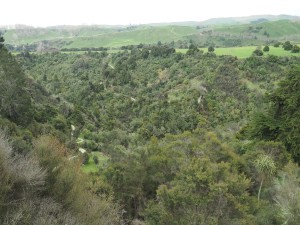 A BCS is a way of creating, measuring and trading units of ‘biodiversity value’ that can be used to fund conservation activities, explains environmental stewardship manager Luka Jansen, who is working with Beef + Lamb NZ on a joint submission.
A BCS is a way of creating, measuring and trading units of ‘biodiversity value’ that can be used to fund conservation activities, explains environmental stewardship manager Luka Jansen, who is working with Beef + Lamb NZ on a joint submission.
The new BCS has been outlined in a discussion document from the Ministry for the Environment (MfE) and Department of Conservation (DOC).
Already custodians of a significant amount of native biodiversity throughout New Zealand, DINZ believes farmers should be recognised for and supported in what they do to protect and enhance ecosystems, explains Jansen.
While BCS could reward farmers for nature-positive activities, and bring in income, DINZ’s concern is that farmers may not be supported and compensated for the work carried out under existing environmental regulations. The new system must take into account the whole ecosystem, she argues.
“Farms and landscapes that have more diverse agriculture and vegetation types receive a greater range of environmental benefits, while providing food for people and communities. For the people to want to join a BCS, incentives and benefits need to be “very clear” and “deer farmer input is vital,” says Jansen.
Deer farmers have been asked to fill in a short survey online here, WHICH WILL CLOSE AT MIDNIGHT TONIGHT (19 October 2023).
DINZ strongly encourages interested farmers to also make their own submissions, directly to MfE. Submissions will close on Friday 3 November 2023.
Read the MfE biodiversity credit consultation here >>
Farmers who have questions or want to discuss the BCS system can contact DINZ environmental stewardship manager Luka Jansen luka.jansen@deernz.org.
New deer research strategy on the way for 2024
A new deer research strategy has been developed by DINZ to align with the new industry direction, with a new single advisory panel replacing the current four working groups.
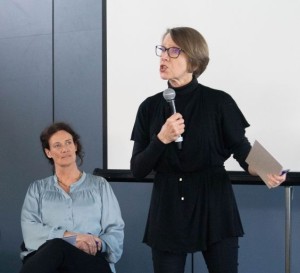
Dr Rowarth (right) explaining the new approach for research to NZDFA branch chairs.
A DINZ board sub-committee, comprising of Dr Jaqueline Rowarth, Dave Courtney, Tony Cochrane and Gerard Hickey, will ensure “strategy is aligned through the research, as well as through all of the activities,” explained Rowarth. She has been looking at the governance of the science and research component within the industry’s new strategic direction.
The sub-committee will take advice from a new research advisory panel. The six-person panel – yet to be appointed – will include two members from the DINZ executive, two NZDFA-appointees, along with two experts.
The changes “will actually mean we are an even more research-driven industry, far more so than some of the other industries,” Rowarth believes.
DINZ policy and research manager Emil Murphy is now working on the new “clearly articulated” strategy that will be ready for sharing in the New Year.
DINZ already funds high-quality research to the tune of over $1.5 million in 2021-2022 through the partnership approach with AgResearch, he explained. That partnership will continue and the changes will tie current work even tighter into the wider industry strategy, which includes researchers as stakeholders. It will also strategically align with AgResearch’s priorities, “as we both need to ensure the money spent on research is well spent,” says Murphy.
Another key DINZ proviso is that when projects are commissioned and delivered, they will need to be able to demonstrate how they are “immediately useful on the ground, whether with an economical, welfare or community benefit.”
Ladley hits the ground running on industry capability
New DINZ industry capability manager John Ladley has hit the ground running in his first month as promised, with visits to Peel Forest Estate and Raincliff stations and farmers in the south, while attending the recent South Island DINZ Road Trip meetings.
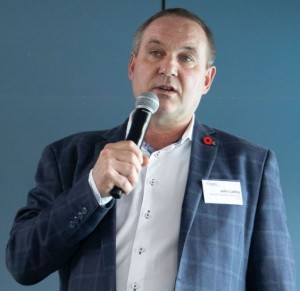
Velvet is right in John Ladley’s headlights
Ladley aims to support the DINZ team, “and then show how we ensure we deliver value for you as deer farmers as well,” he told NZDFA branch chairs last week.
In his team are projects manager industry capability Sara Elmes, quality systems administrator Pam MacLeman and two part-timers, DeerSelect manager Sharon McIntyre and Johne’s programme manager Kathy Goodwin-Ray.
His role is split into three parts: genetics; quality assurance; and industry capability.
Gaining an understanding of deer genetics from McIntyre, together they’ll be working to “ensure the right genetic tools and resources are available for those in the breeding and commercial space.”
Velvet “is right in my headlights” as velvetting has already started and he’s learning more about the NVSB and VelTrak quality assurance from MacLeman. He’s getting to grips too with the deer-specific elements of NZFAP and NZFAP+, plus DeerQA and the transport code.
Industry capability is where Ladley feels most comfortable and he was “really pleased” to see the work going on with rural professionals. He’ll support Elmes, who will be working on farm planning and extension programmes – including Advance Parties and Environment Groups.
Another focus for Ladley will be on finding ways to bring new people into the sector, through working with Primary ITO, Growing Future Farmers, training colleges and others.
Where do our leaders stand?
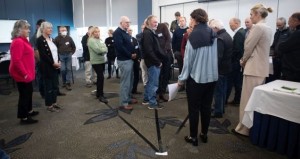
Looking from the past to the future, participants finding their positions.
DINZ chair Mandy Bell led a revealing exercise at the NZDFA branch chairs meeting to tease out where the leaders “all are as individuals. Are we holders of the past, are we front of mind living in the present, or are we people that tend to be those dreamers and creators of the future and opportunities, or somewhere in between?”
Participants placed themselves on a triangle with ‘dreamers’ – opportunity creators – ‘doers’ and ‘past’ on each of its points.
The exercise fully engaged participants, with plenty of discussion.
Around a quarter were looking to create opportunity, the majority were ranged between ‘opportunity creators’ and ‘doers’, as you’d expect from a farming group, but nobody had their feet placed at the past – though all agreed it was important to take the lessons learned from the past ahead with them.
New support for NZDFA branches
New manuals are on the way for NZDFA branches to help with communication and administration, DINZ producer manager Lindsay Fung advised the branch chairs.
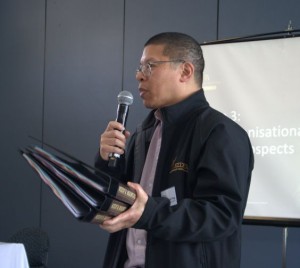
Lindsay Fung with the sample folders.
The proposed format had been, “shamelessly stolen,” Fung admitted, from the successful and easy-to-use Deer Facts format. He had prototype copies of the A4 ring-binder and mocked-up contents available for review by participants. Early comments received “suggested there’s some good support” for the initiative.
Contents will include essential information about the NZDFA, with tabs for Branch Administration, Events, National Administration, NZDFA Governance and Contacts.
“The manual will make it a lot easier when you join the National Executive too, as you’ll have a lot more knowledge of the constitution and so on,” noted NZDFA chair Justin Stevens.
Once everything is finalised, NZDFA will issue the first one – possibly at next May’s Deer Industry Conference – then updates will be sent to branches as they are published and also downloadable.
Deer farmers getting prepared for a long, hot and dry El Ninõ summer
It’s no secret El Ninõ will be strutting its stuff this summer, for the first time since 2016, meaning a long, hot and dry summer is on the way.
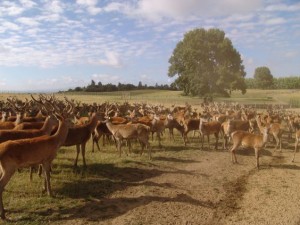
”Hurry up, we’re hungry.” Photo: Hub Hall.
Deer farmers, particularly on the east of both islands, will be looking at stronger seasonal winds and higher temperatures, along with “dramatic temperature swings”. NIWA is closely monitoring the developing climate situation and forecasts lower than usual rainfall in the northern and eastern parts of the country and above normal in the west and lower South Island. The winds will also increase wildfire risk.
“Deer farmers will be getting prepared for the coming conditions, putting together action plans in case of unusually dry weather and also keeping in close contact with their livestock agents or meat processors,” notes DINZ producer manager Lindsay Fung.
Support will also be available through the Ministry for Primary Industries (MPI)/Federated Farmers’ Feed Coordination Service for those needing help with stock-feeding.
“It will also be particularly important for farmers to look after themselves, during what could be a trying summer.”
DINZ’s feed calculator and ‘Drought Feeding and Management’ Deer Fact will be helpful for farmers in their drought planning. Other resources are available from Beef + Lamb NZ and MPI. The latter has just updated its ‘Feed in dry times – Get prepared early’ factsheet, which has been uploaded to its website.
Another new free tool, developed over the past three years with farmers and growers, has been launched by NIWA and MPI. The Drought Forecasting dashboard uses AI and long-range weather modelling to give week-to-week predictions of rainfall, dryness and potential drought 32 days into the future. Updated daily, the outlook captures the latest changes and is a companion to MPI’s NZ Drought Index.
See the ‘Drought Feeding and Management’ Deer Fact >>
B+LNZ’s useful ‘Drought Resources’ webpage >>
Drinking water suppliers need to get registered
Very small and medium drinking water suppliers in New Zealand need to be thinking about getting registered, if they haven’t already.
 The body responsible for water safety Taumata Arowai – set up under the Water Services Act, which came into effect on 15 November 2021 – has some new advice for assessing and managing risks across water supply through drinking water safety planning.
The body responsible for water safety Taumata Arowai – set up under the Water Services Act, which came into effect on 15 November 2021 – has some new advice for assessing and managing risks across water supply through drinking water safety planning.
All drinking water suppliers must complete a drinking water safety plan (DWSP) as part of their registration. This is a risk management process aiming to ensure a safe, reliable and resilient supply of drinking water to consumers. It records the hazards and risks to drinking water supplies and how they will be managed to ensure drinking water is safe.
Registered suppliers will have already submitted their DWSPs, but drinking water suppliers who haven’t done so yet have until November 2025 to get registered and then until November 2028 to complete a DWSP.
More information, guidance and templates for very small supplies (up to 25 people), small supplies (26-100) and medium supplies (101-500 people) are available from the Taumata Arowai website.
Velvetters reminded to check details are correct in VelTrak
Check your details are correct, velvetters are being reminded as velvetting starts this month.
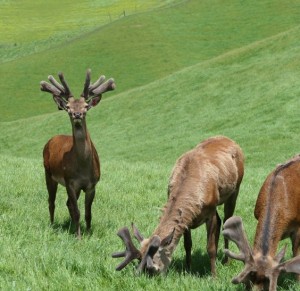
Ready for velvetting? Photo: Grant Charteris.
Those undergoing Regulatory Control Scheme (RCS) and velvetter audits should have been notified by email – if not, they will be contacted soon, says DINZ quality systems administrator Pam MacLeman.
If farmers have not received an email and have changed email addresses, they can log into the VelTrak system to update that and also any changes to trading names.
Anybody that has changed farms since last season will need a new VelTrak login, as it is linked to the farm the tags have been assigned to.
“Changed addresses, however, must be advised to DINZ as soon as possible as the tags are only allocated to the original farm address on VelTrak,” says MacLeman.
DINZ’s October update also reminds velvetters that if their facilities are sitting in ‘awaiting action’ after an audit, that they will be unable to approve Velvet Status Declarations (VSDs) until the premises have passed the audit. “So, it is best to ensure they are in approval order at the time of audit,” she says.
Also remember: All Velvet Status Declarations (VSDs) still need to be approved this season.
Most velvetters will have already paid NVSB fees – or will need to by 20 November – have organised their supervisory visits and ordered velvetting drugs and VelTrak® tags.
Deer farmers can refer to the Farmer VelTrak manual to update themselves and read up on best practice in the Velvet Antler Removal Deer Fact.
Any queries, contact DINZ on info@deernz.org or by phone on 04-473 4500.
”Deer Joe” on the menu at Joe’s Garage
New Zealand café and restaurant chain Joe’s Garage has added a new venison burger to its menus throughout the country. The star of the new “Deer Joe” burger is sourced from South Island deer farms for Merchant of Venison (MoV).

The $24 ”Deer Joe” burger features a premium New Zealand venison patty with streaky bacon, beetroot relish, caramelised onions and lettuce.
MoV’s James and Angela Petrie were involved in its development and were excited to see the launch last week, says James Petrie.
“We hope it will be hugely popular and stays on their menu for a long time.”
The Petries have a track record and “great relationship” with Gerhard Zitenbacher, the overall executive chef for Lone Star and sister company Joe’s Garage.
Lone Star first put a “Deer John” venison steak on its menus in June 2015, which is still successful today,” he explains.
DINZ executive chef Graham Brown, who has been assisting MoV’s promotional activities, was drafted in to help demonstrate menu ideas using venison ribs, osso bucco and the venison burger to Katie Duncan, Joe’s Garage’s head of operations in May this year.
“Originally, they were thinking they would go with the venison ribs as they were a real hit,” reports Petrie, but in the end Brownie’s recipe for venison burger, incorporating 100 percent farmed venison mince with no added fat, was the “star of the show.”
From the restaurant’s perspective: “We love that it’s a stunning, premium New Zealand product, delivered in a Joe’s way at a Joe’s price, which makes it accessible to all,” says Duncan. “And, it is SERIOUSLY delicious.”
Fit-for-purpose DINZ team now complete
With a full complement of staff now, there is now more of a “team approach” to the DINZ organisational structure.
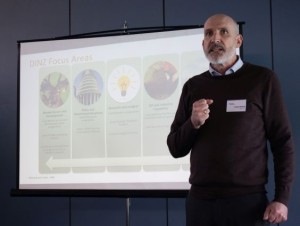
Innes Moffat is now starting work on briefings for incoming government ministers.
Markets manager (Rhys Griffiths), policy and research manager (Emil Murphy), producer manager (Lindsay Fung) and new industry capability manager (John Ladley), who joined the team last month, are now heading up their teams, working across projects and reporting directly to chief executive Innes Moffat.
Five full-time roles were disestablished, and work has been reallocated. Six part-timers are now employed in specialist roles, “deliberately so,” for activities like DeerSelect and Johne’s monitoring, Moffat explained to the NZDFA branch chairs.
Insight is a new function for DINZ. The industry has been “quite data poor,” he noted.
“We will be putting more effort into the collection of good information, which will help people make more informed decisions,” said Moffat
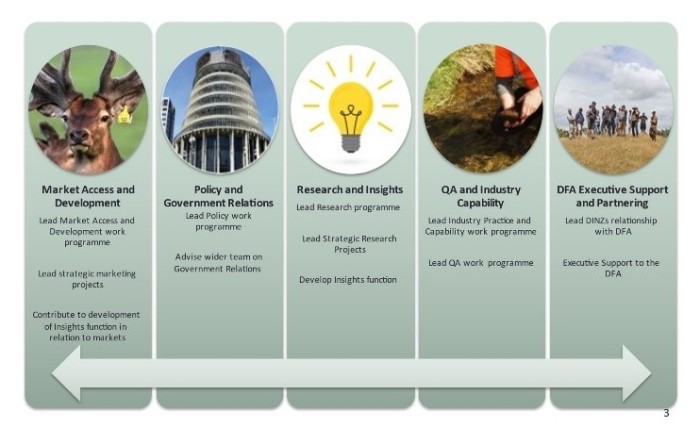
Work for the DINZ executive team is now focused in five areas.
Another focus will be “making sure communications are on point.”
The DINZ board “will be taking a keen interest in performance targets,” he noted.
Now restructuring is complete, Moffat is turning his mind to other things, like completing the full deer industry briefing for the incoming new National/Act government. Also on the list, he says, “is providing briefings for incoming ministers in the new Government and working with officials on ensuring that the deer industry’s views are considered in the development of new policy areas.”
To see who’s where check out the new organisational structure here >>
Introducing: DINZ environmental stewardship manager Luka Jansen
New DINZ environmental stewardship manager Luka Jansen joined DINZ at the end of September, arriving ready-to-go from her previous position with Horizons Regional Council.
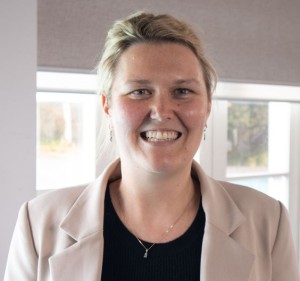
Luka Jansen, DINZ’s new environmental stewardship manager.
Reporting to DINZ policy and research manager Emil Murphy, she’s looking after all things environmental.
Jansen will be working with individual deer farmers, NZDFA branches, the DINZ executive team and new project manager industry capability, Sara Elmes, whom she has replaced. She aims, “to help ensure deer farming remains a profitable, sustainable land-use within accepted environmental constraints.”
Well qualified for her new role, Jansen’s background is in sheep, beef and deer drystock farming in the Waikato, Bay of Plenty and King Country. She graduated in resource and environmental planning from Massey University in 2013, before joining Horowhenua District Council as planning team leader, moving to Horizons in around 2015, where she worked for eight years as a planner in the regulatory team.
“Delighted” to have joined DINZ – where day-to-day Jansen will be responsible for environmental policy, regulation and societal perceptions impacting producers – she reports a “passion for helping farmers with their challenges and finding solutions.”
One of the first jobs on her desk is working on consultation for the government’s newly proposed biodiversity credit scheme (see above). She’ll also be attending the Environmental Field Day on 1 December showcasing Richard and Sarah Burdon’s Glen Dene station, winners of this year’s Supreme Environmental Award.
On her days off, the mum of two girls aged three and six and “strong Chiefs supporter”, enjoys “traipsing through the Urewera Ranges and other remote areas in search of deer,” and is an obsessive gardener.
SHORTS
- Read and listen: ‘Aviation and deer industry trailblazer Sir Tim Wallis dies aged 85’, 18 October 2023, Radio NZ
- Read: ‘Deer farmer fined for not tagging animals’ October 2023 Rural News
- Read: ‘Soft sell’ New Zealand deer down is being sold for luxury apparel and talked about in Air NZ’s October 2023 Kia Ora magazine (pp 88-89)
- Read: ‘Deer industry shifts venison away from European restaurants and into stable US supermarkets’, Gerard Hickey and Innes Moffat talk to The Post, 19 September 2023
- Listen: Deer Industry News editor Lynda Gray talks to Rural Exchange Today, 15 September 202
EVENTS
Click on the bold links below to get more information about any of the events.
- SCNO 2023 Velvet & Hard Antler Competition – Friday 24th November 2023, Phar Lap Race Course, 8 Pleasant Point Hwy, Washdyke, Timaru. Register and more information >>
- North Island Velvet Competition and Awards Dinner – 5.00-11.00pm, Saturday 25 November 2023, Manfeild Stadium, Feilding. Cost and details: TBC. Contact: Craig Hocken, chocken@inspire.net.nz. Phone 0274-576 388
- Environmental Award field day: Glen Dene - 9.30am-4.00pm Friday 1 December, The Beehive, Lake Hawera, Wanaka. Attend a field day to celebrate Glen Dene winning the 2023 Deer Industry Elworthy Environmental Award and the First Light Award. Contact: rebecca.norling@deernz.org
- 41st National Velvet & Trophy Antler Competition, Awards Night
Friday 8 December 2023, Invercargill. Contact: southlanddeerbranch@gmail.com - 2023-2024 Stag, Hind and Wapiti Bull Sales – Running from 11.00am-5.00pm. 8 December 2023 to 16 January 2024, 19 events at various venues.
- CK Import Export Rising Stars velvet competition
4.00pm – 12.00am, Saturday 9 March 2024. Contact campbell.clarke@xtra.co.nz or phone 07 873 2785.


